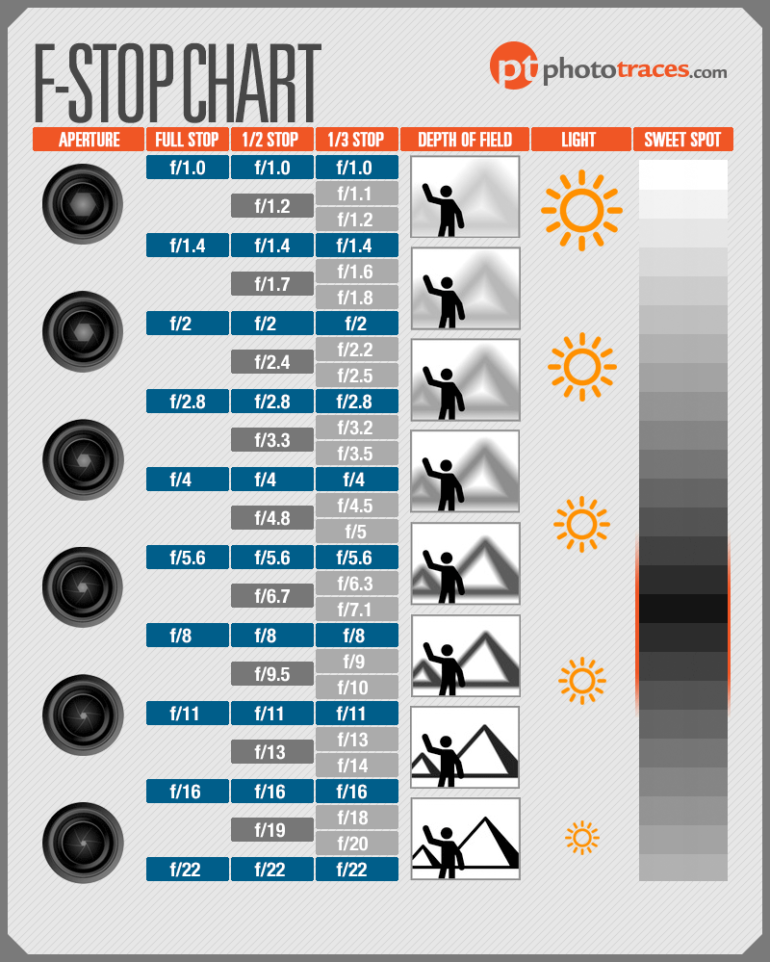


In this article we examine Aperture in detail, and mathematically explain where the Aperture “f-numbers” come from. The Aperture Scale consists of a seemingly odd set of decimal and whole numbers, and getting your head around these values is not at all easy for Beginner Photographers.
F stop list full#
You can access this article at the following link:Īn understanding of Aperture is critically important to isolate subjects in portraits and get full detail in Landscape pictures. It is a good idea to read our previous article on “How To Do Camera Settings” before working through this Aperture Article.
F stop list iso#
The other two are ISO Light Sensitivity and Shutter Speed. Having the three bracketed images lowers the amount of post-processing time that they might have to spend.Aperture is one of the key variables in Digital Photography. Many photographers still use the technique today, so they have the exposure that they want. In the three images in the above example, you might prefer the overexposed (by 2 stops) image because the setting sun is most brilliant.īracketing was a technique that was popularized from shooting slide film, due to the limited ability to correct the image in the darkroom.

Then you can review the three (or more) exposures, see the subtle but critical differences in the images, and decide which one is the best image for your purposes. So, “Auto Bracketing” is a function in which you set the EV value then release the shutter and the camera automatically makes the necessary up and down adjustments to the EV to give you the bracketed exposures. On most digital cameras this is ISO 100, although some high end DSLRs have a mode that brings the ISO down to 50 or even 25.Īuto Bracketing is an exposure technique whereby you can ensure that you have the optimal exposure by taking at least three (3) exposures of the exact same composition with one at the metered EV, one at 1/3 of a stop below the metered EV and one at 1/3 of a stop above the metered EV. The digital camera engineers have designed the image sensor to perform best at the lowest ISO (just like with film). It is any light signal that does not originate from the subject, and therefore creates random color in an image. The higher the ISO rating (more sensitive) the stronger the image sensor has to work to establish an effective image, which thereby produces more digital noise (those multi-colored speckles in the shadows and in the midtones). The lower the ISO rating, the less sensitive the image sensor is and therefore the smoother the image, because there is less digital noise in the image. The ISO rating, which ranges in value from 25 to 3200 (or beyond), indicates the specific light sensitivity. ISO is actually an acronym, which stands for International Standards Organization, which is the organization that standardizes sensitivity ratings for camera sensors. It is impossible to make an independent change in one of the elements and not obtain an opposite effect in how the other elements affect the image, and ultimately change the EV. Increasing the ISO, allows for shooting in lower light situations, but you increase the amount of digital noise inherent in the photo. However, reducing shutter speed (keeping the shutter open longer) also increases the amount of light hitting the image sensor, so everything is brighter. Reducing the shutter speed affects how motion is captured, in that this can cause the background or subject to become blurry. When these three elements are combined, they represent a given exposure value (EV) for a given setting.Īny change in any one of the three elements will have a measurable and specific impact on how the remaining two elements react to expose the film frame or image sensor and how the image ultimately looks.įor example, if you increase the f-stop, you decrease the size of the lens’ diaphragm thus reducing the amount of light hitting the image sensor, but also increasing the DOF (depth of field) in the final image.


 0 kommentar(er)
0 kommentar(er)
